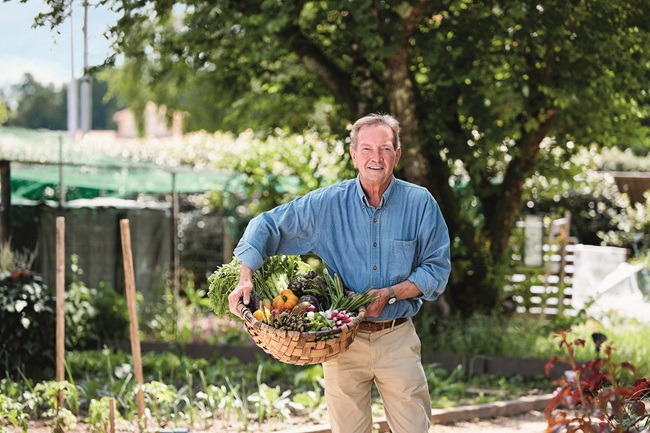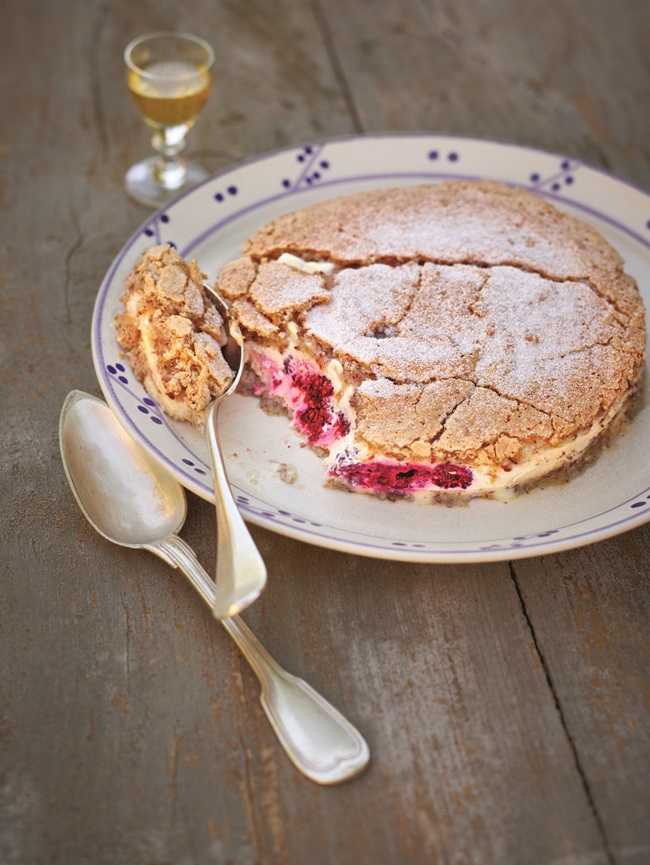Cooking Specialties From the Périgord With the Father of Bruno, Chief of Police

Co-authored with his wife, the food writer and novelist Julia Watson, Martin Walker, the bestselling author of the Bruno, Chief of Police novels set in the Périgord, has written a cookbook packed with Périgourdin culinary favourites.
FRIED POTATOES, SARLAT-STYLE
Pommes de terre sarladaises
It would be unthinkable to visit the Périgord without eating this, one of its star dishes. Garlicky, unctuous and devised in the medieval town of Sarlat, from which it takes its name, it’s the natural partner to duck confit. Potatoes are thinly sliced, then slowly sautéed in duck fat, with a persillade, a finely chopped mix of a generous handful of parsley leaves and copious peeled cloves of garlic (the cook chooses how many), which is folded through just before serving. Bruno likes it with a couple of fried eggs on top for a weekend breakfast.
Serves 4
INGREDIENTS
- 1 llb (500 g) waxy potatoes, peeled
- 6 to 8 cloves garlic, peeled
- Large bunch of fresh flat-leaf parsley. stalks removed
- 4 tbsps duck or goose fat or, at a pinch, unsalted butter
METHOD
- Thinly slice the potatoes on a mandoline or with a sharp knife. Wash them in several rounds of fresh water, till the water is clear of starch. Spread the potatoes on a clean tea towel to dry.
- Roughly chop the garlic, add it to the parsley leaves and finely chop the two together to make a persillade.
- Melt the duck fat in a sauté pan till it’s hot but not smoking and add the potatoes.
- Toss gently until the slices are all covered in fat. Lower the heat and continue cooking to soften the potatoes, turning the slices regularly and carefully. When they have become a light golden colour, in 30 to 40 minutes, add the persillade, fold it through the potatoes and turn the mixture onto a warmed platter to serve.
Note: In the classic version of this dish, sliced truffles are added with the persillade. Another version has thin slices of duck-fat-sautéed ceps (porcini) folded in 15 minutes before the end to cook along with the potatoes. A persillade can also be used to add punch to roast chicken, grilled steak, tomato-sauce-dressed dishes, or a simple buttered baked potato.

© Bruno Cookbook
CEPS WITH POTATOES, GARLIC AND GOAT’S CHEESE
Ceps avec pommes de terre, l’ail et Crottin
After autumn rain showers, Périgord mushroom- hunters go foraging. Cars park along the verges of forested lanes and their passengers disperse furtively in search of ceps (porcini). Everyone has their favourite secret place. There is a mild controversy, pointless from a Périgourdin’s point of view, over the correct spelling of ‘ceps’. In Paris, where the mushrooms don’t grow in the city parks, they are spelled ‘cèpes’.
Serves 4
INGREDIENTS
- 8% oz (250 g) fingerling, Ratte or other waxy potatoes, scrubbed or peeled and quartered
- 1 lb (500 g) ceps
- ¼ cup (2 oz / 60 ml) extra virgin oil, plus 2 tbsps duck fat or extra-virgin olive oil for flavour
- 1 small shallot, peeled, finely chopped
- 2 cloves garlic, peeled, finely chopped
- 1 tbsp fine breadcrumbs
- 2 tbsps roughly chopped fresh flat-leaf parsley
- ½ lemon
- Salt and freshly ground black pepper, to taste
- 4 rounds of goat’s cheese, such as Crottin or Rocamadour
METHOD
- In a large pot, boil the potatoes till just cooked. Drain and reserve them.
- Wipe the ceps clean with a damp paper towel. Remove their stems, slice off their bases, roughly chop them and set them aside.
- Thickly slice each cep’s cap.
- Heat the oil and the duck fat, if using, or the extra 2 tbsps of oil in a large pan, add the cep caps and potatoes and sauté them over medium heat for about 8 to 10 minutes, tossing frequently. Add the chopped stems, shallot and garlic and toss continuously for another 2 to 3 minutes, Lower the heat, cover and continue to cook, another 5 minutes. Remove the lid and spoon off any remaining oil. Add the breadcrumbs and two-thirds of the chopped parsley. Stir everything and leave it cooking over low heat so the breadcrumbs absorb the remaining juices. Squeeze the lemon juice over it, season and stir.
- Slice the goat’s cheese into 1/4-inch (3 cm)-thick rounds, lay these over the top of the ceps and cover the pan with the lid. Continue to heat this for 2 to 3 minutes, to allow the cheese to slump, melting just enough so it retains its shape. Sprinkle the remaining parsley over everything and serve it directly from the pan with warm crusty bread to mop up the juices.

RABBIT WITH PRUNES
Lapereau aux pruneaux
When Bruno’s troupe of hunting friends bring down a wild autumn rabbit or two, this is the dish they make. Rabbit, stewed or roasted, and often served with a grainy mustard sauce, makes a common dish across the Périgord, with locals breeding them for the pot in large huts on their allotments.
Serves 4
INGREDIENTS
- 1 rabbit, 3 lbs 3 oz (1½ kilograms), jointed by your butcher
- Leaves from a few sprigs of fresh thyme, finely chopped
- 2 tbsps duck fat or oil
- 3 large shallots, peeled, finely chopped
- 2 bay leaves
- 20 pitted prunes (preferably pruneaux
- d’Agen, or substitute any good-quality organic prunes)
- I cup (8 fluid oz / 237 ml) Bergerac red or other robust red wine
- I cup (8 fluid oz / 250 ml) chicken or veal stock
- I clove garlic, peeled
- Salt and freshly ground black pepper, to taste
METHOD
- Rub the rabbit pieces with the chopped thyme leaves and place them in a ziplock bag to infuse for an hour on the counter or overnight in the fridge. Return to room temperature before cooking.
- Warm the duck fat in a lidded casserole with a lid over medium-high heat and brown the rabbit all over. Add the shallots and bay leaves, sauté briefly, then add the prunes, wine and stock.
- Smash the garlic with the flat of a knife, add it to the pan, season everything with salt and freshly ground pepper and cover tightly with the lid. Braise very gently for 1½ hours.
- Take the lid off, remove the rabbit joints and put them on a warmed platter and cover loosely with foil, then tum the heat up to reduce the liquid by half.
- Distribute the prunes around the rabbit joints, pour the sauce over them and serve with a potato purée or with an equally plain side dish – ideally one which will help mop up all those delicious juices.

© Bruno Cookbook
WALNUT MERINGUE CAKE
Gâteau meringué aux noix
Gâteau aux noix is a Périgord speciality, a one-layer cake, a little mealy and dense, made from ground walnuts. Pamela, with whom the still-devoted Bruno once had a happy affair, introduced him early in their courtship to this much lighter nut cake from her Scottish childhood which is made with hazelnuts and served in one layer with a topping of cream and wild raspberries. She has adapted it to make two layers which are then sandwiched together around the filling.
Serves 4
INGREDIENTS
- Unsalted butter, softened for greasing
- 4 egg whites
- 8 oz (225 g) sugar
- 24 oz (75 g) walnuts, or hazelnuts, ground
- 1 cup (1½ pint/ 240 ml) heavy whipping cream
- 8 oz/250 g raspberries
- 1 scant tbsp confectioner’s sugar
METHOD
- Preheat the oven to 375°F/190°C.
- Generously butter two 7 in (18 cm) sandwich tins and line them with buttered parchment paper.
- Whisk the egg whites to soft peaks and then add the sugar, I tbsp at a time, all the while beating till stiff. Fold in the nuts.
- Divide the mixture evenly between the two tins and distribute it by tapping them on the kitchen counter to settle. Bake for 30 to 40 minutes maximum, till the top is crisp but the inside is still soft. Set them on racks in their tins to cool; then carefully lift them out and peel the paper from both bottoms.
- Whisk the cream till it’s thick and smooth it over the top of one cake. Cover it with raspberries and place the second cake layer on top. Sieve a little confectioner’s sugar over that, and serve.
From France Today Magazine

Bruno’s Cookbook, Recipes and Traditions from a French Country Kitchen
By Martin Walker and Julia Watson
Lead photo credit : Martin Walker
Share to: Facebook Twitter LinkedIn Email
More in Dordogne, Food, French food, French recipes, Périgord
Leave a reply
Your email address will not be published. Required fields are marked *




